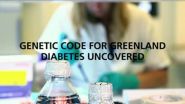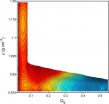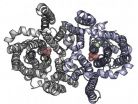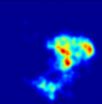(Press-News.org) Korean research team revealed conflicting climate change patterns between the middle latitude areas of the Northern and Southern Hemispheres in relation to glacial and interglacial cycles which have been puzzled for the past 60 years.
Doctor Kyoung-nam Jo from the Quaternary Geology Department of the Korea Institute of Geoscience and Mineral Resources(KIGAM) revealed a clue for solving the riddle of past global climate change in his paper titled 'Mid-latitudinal interhemispheric hydrologic seesaw over the past 550,000 years' which was featured in the journal Nature.
This study collected samples from the stalagmites and flowstones in limestone caves which are called 'hard disks' containing the past climate change data and revealed how much they grew in which eras through isotope analysis and age dating, and traced the past climate changes by applying them to global climate change over 550,000 years.
For this study, Doctor Jo explored over 200 caves in Korea and collected 24 samples from stalagmites and flowstones in 15 limestone caves. As a result of analyzing the growth through U-series age dating, it was found that they grew well during interglacial eras when it was warm and moist, whereas their growth stagnated during glacial eras. By comparing this data with existing external climate change data which were obtained from solar insolation, glaciers, and deep sea sediments, he found that the same climate change phenomena appeared in the same periods.
In particular, he and colleagues revealed the fact that climate changes in the Northern and Southern Hemispheres showed opposite tendencies by analyzing the fact that stalagmites and flowstones in the temperate zones of the Northern and Southern Hemispheres had opposite growth periods. This suggests for the first time that the so-called phenomenon of the interhemispheric hydrological seesaw that the precipitation changes in the tropical regions show opposing tendencies between Northern and Southern Hemispheres had been spread to the temperate region in which the Korean peninsula was located at least for the last 550,000 years.
Due to the interhemispheric hydrological seesaw, when it rains frequently in a region that belongs to the intertropical convergence zone (ITCZ), it accelerates the growth of plants and increases the temperature, whereas other areas exhibit cold dry weather. This theory has been applied only to the tropical region and had not been significance in global climate change. However, if it is expanded to the temperate regions by the study of Doctor Jo, the seesaw phenomenon may be regarded as another key factor besides the insolation change which has been regarded as the most powerful factor in the glacial and interglacial cycles.
The findings of this study are attracting very keen interest from academic circles because they can be used to explain past climate change and predict future climate change. In particular, as the different climate change mechanisms by region were revealed, it is expected that a more accurate global climate change model could be created.
Doctor Jo said, "Geology research such as ancient climate research is usually regarded as something that is distant from our daily lives, but it is the only way to understand the effects of large-scale climate changes that actually happened in the past. In order to more accurately assess serious climate change events and the impacts that human beings will experience, it is essential to continuously discuss with domestic scholars as well as to participate in large-scale international joint research programs such as the IODP(International Ocean Discovery Program).
INFORMATION:
Doctor Kyoung-nam Jo is a specialist on the research of ancient climates using cave products. After graduating from the department of geology of Kangwon National University, he received master and doctorate degrees in the graduate school of the same university. Now he is conducting research in the Korea Institute of Geoscience and Mineral Resources.
Identifying opposite patterns of climate change between the middle latitude areas
2014-06-18
ELSE PRESS RELEASES FROM THIS DATE:
Evolutionary biology: Why cattle only have 2 toes
2014-06-18
During evolutionary diversification of vertebrate limbs, the number of toes in even-toed ungulates such as cattle and pigs was reduced and transformed into paired hooves. Scientists at the University of Basel have identified a gene regulatory switch that was key to evolutionary adaption of limbs in ungulates. The study provides fascinating insights into the molecular history of evolution and is published by Nature today.
The fossil record shows that the first primitive even-toed ungulates had legs with five toes (=digits), just like modern mice and humans. During their ...
Scientists break the genetic code for diabetes in Greenland
2014-06-18
VIDEO:
New Danish genetics research explains the high incidence of type 2 diabetes in the Greenlandic population. The ground-breaking findings have just been published in the prestigious scientific journal Nature....
Click here for more information.
A spectacular piece of detective work has mapped a special gene variant among Greenlanders which plays a particularly important role in the development of type 2 diabetes. The results have been published in Nature and can be ...
Familiar yet strange: Water's 'split personality' revealed by computer model
2014-06-18
Seemingly ordinary, water has quite puzzling behavior. Why, for example, does ice float when most liquids crystallize into dense solids that sink?
Using a computer model to explore water as it freezes, a team at Princeton University has found that water's weird behaviors may arise from a sort of split personality: at very cold temperatures and above a certain pressure, water may spontaneously split into two liquid forms.
The team's findings were reported in the journal Nature.
"Our results suggest that at low enough temperatures water can coexist as two different ...
Collecting light with artificial moth eyes
2014-06-18
Rust – iron oxide – could revolutionise solar cell technology. This usually unwanted substance can be used to make photoelectrodes which split water and generate hydrogen. Sunlight is thereby directly converted into valuable fuel rather than first being used to generate electricity. Unfortunately, as a raw material iron oxide has its limitations. Although it is unbelievably cheap and absorbs light in exactly the wavelength region where the sun emits the most energy, it conducts electricity very poorly and must therefore be used in the form of an extremely thin film in ...
Breathalyzer test may detect deadliest cancer
2014-06-18
Lung cancer causes more deaths in the U.S. than the next three most common cancers combined (colon, breast, and pancreatic). The reason for the striking mortality rate is simple: poor detection. Lung cancer attacks without leaving any fingerprints, quietly afflicting its victims and metastasizing uncontrollably – to the point of no return.
Now a new device developed by a team of Israeli, American, and British cancer researchers may turn the tide by both accurately detecting lung cancer and identifying its stage of progression. The breathalyzer test, embedded with a "NaNose" ...
Scripps Research Institute scientists reveal molecular 'yin-yang' of blood vessel growth
2014-06-18
LA JOLLA, CA—June 18, 2014 —Biologists at The Scripps Research Institute (TSRI) have discovered a crucial process that regulates the development of blood vessels. The finding could lead to new treatments for disorders involving abnormal blood vessel growth, including common disorders such as diabetic retinopathy and cancer.
"Essentially we've shown how the protein SerRS acts as a brake on new blood vessel growth and pairs with the growth-promoting transcription factor c-Myc to bring about proper vascular development," said TSRI Professor Xiang-Lei Yang. "They act as the ...
Inflammation in fat tissue helps prevent metabolic disease
2014-06-18
DALLAS – June 18, 2014 – Chronic tissue inflammation is typically associated with obesity and metabolic disease, but new research from UT Southwestern Medical Center now finds that a level of "healthy" inflammation is necessary to prevent metabolic diseases, such as fatty liver.
"There is such a thing as 'healthy' inflammation, meaning inflammation that allows the tissue to grow and has overall benefits to the tissue itself and the whole body," said Dr. Philipp Scherer, Director of the Touchstone Center for Diabetes Research and Professor of Internal Medicine and Cell ...
Unlocking the therapeutic potential of SLC13 transporters
2014-06-18
Researchers have provided the first functional analysis of a member of a family of transporter proteins implicated in diabetes, obesity, and lifespan. The study appears in the June issue of The Journal of General Physiology.
Members of the SLC13 transporter family play a key role in the regulation of fat storage, insulin resistance, and other processes. Some SLC13 transporters mediate the transport of Krebs cycle intermediates—compounds essential for the body's metabolic activity—across the cell membrane. Previous studies have shown that loss of one member of this family ...
Penn team links placental marker of prenatal stress to brain mitochondrial dysfunction
2014-06-18
When a woman experiences a stressful event early in pregnancy, the risk of her child developing autism spectrum disorders or schizophrenia increases. Yet how maternal stress is transmitted to the brain of the developing fetus, leading to these problems in neurodevelopment, is poorly understood.
New findings by University of Pennsylvania School of Veterinary Medicine scientists suggest that an enzyme found in the placenta is likely playing an important role. This enzyme, O-linked-N-acetylglucosamine transferase, or OGT, translates maternal stress into a reprogramming ...
Study examines how brain 'reboots' itself to consciousness after anesthesia
2014-06-18
One of the great mysteries of anesthesia is how patients can be temporarily rendered completely unresponsive during surgery and then wake up again, with their memories and skills intact.
A new study by Dr. Andrew Hudson, an assistant professor in anesthesiology at the David Geffen School of Medicine at UCLA, and colleagues provides important clues about the processes used by structurally normal brains to navigate from unconsciousness back to consciousness. Their findings are currently available in the early online edition of the Proceedings of the National Academy of ...







